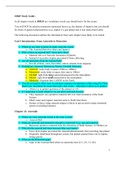Other
Western University Earth Science 1086F Final Exam Study Guide
- Institution
- University Of Western Ontario (UWO )
This is a full study guide for UWO's Earth Science 1086F Final Exam. Topics include: Meteorites, Asteroids, Planets, Plutoids and TNOs, Comets, and Life in the Universe.
[Show more]



